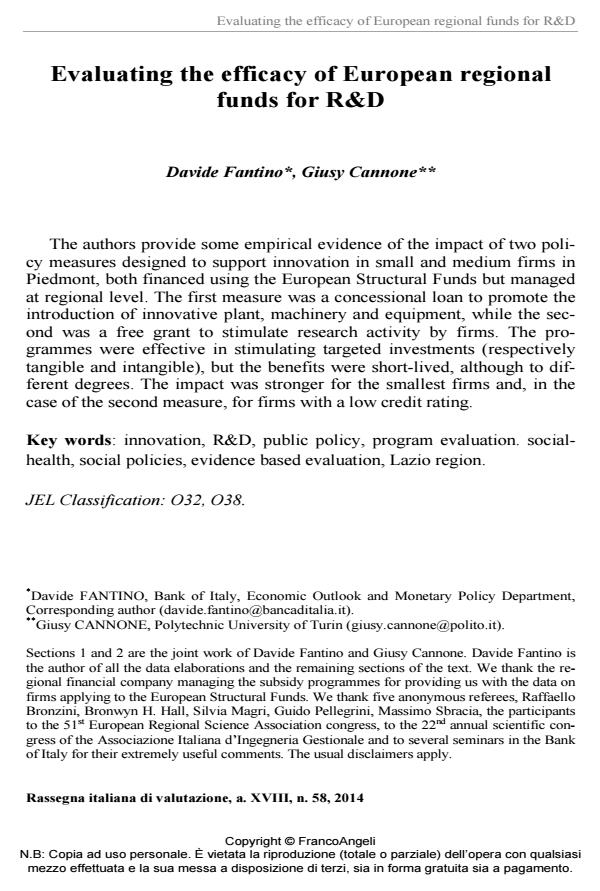Evaluating the efficacy of European regional funds for R&D
Journal title RIV Rassegna Italiana di Valutazione
Author/s Davide Fantino, Giusy Cannone
Publishing Year 2015 Issue 2014/58 Language English
Pages 32 P. 165-196 File size 272 KB
DOI 10.3280/RIV2014-058008
DOI is like a bar code for intellectual property: to have more infomation
click here
Below, you can see the article first page
If you want to buy this article in PDF format, you can do it, following the instructions to buy download credits

FrancoAngeli is member of Publishers International Linking Association, Inc (PILA), a not-for-profit association which run the CrossRef service enabling links to and from online scholarly content.
The authors provide some empirical evidence of the impact of two policy measures designed to support innovation in small and medium firms in Piedmont, both financed using the European Structural Funds but managed at regional level. The first measure was a concessional loan to promote the introduction of innovative plant, machinery and equipment, while the second was a free grant to stimulate research activity by firms. The programmes were effective in stimulating targeted investments (respectively tangible and intangible), but the benefits were short-lived, although to different degrees. The impact was stronger for the smallest firms and, in the case of the second measure, for firms with a low credit rating.
Keywords: Innovation, R&D, public policy, program evaluation. socialhealth, social policies, evidence based evaluation, Lazio region.
Jel codes: O32, O38
- Almus M., Czarnitzki D. (2003). The Effects of Public R&D Subsidies on Firms’ Innovation Activities: The Case of Eastern Germany. Journal of Business and Economic Statistics, 21(2): 226-236. DOI: 10.1198/07350010328861891
- Arrow K.J. (1962). Economic Welfare and the Allocation of Resources for Invention. In: Nelson R., editor, The Rate and Direction of Inventive Activity. Princeton University Press.
- Blundell R., Costa Dias M. (2000). Evaluation Methods for Non-Experimental Data. Fiscal Studies, 21(4): 427-468. DOI: 10.1111/j.1475-5890.2000.tb00031.
- Bronzini R., de Blasio G. (2006). Evaluating the Impact of Investment Incentives: the Case of Italy’s Law 488/1992. Journal of Urban Economics, 60: 327-349. DOI: 10.1016/j.jue.2006.03.00
- Bronzini R., Iachini E. (2014). Are Incentives for R&D Effective? Evidence from a Regression Discontinuity Approach. American Economic Jornal: Economic Policy, forthcoming.
- Bronzini R., Piselli P. (2014). The Impact of R&D Subsidies on Firm Innovation. Temi di Discussione Banca d’Italia n. 960.
- Busom I. (2000). An Empirical Evaluation of the Effects of R&D Subsidies. Economics of Innovation and New Technology, 9(2): 111-148. DOI: 10.1080/1043859000000000
- Carmignani A., D’Ignazio A. (2011). Financial Subsidies and Bank Lending: Substitutes or Complements? Micro Level Evidence from Italy. Temi di Discussione Banca d’Italia n. 803.
- Cariola M., Calabrese G., Rolfo S. (2000). “Principi teorici ed evidenze empiriche nella valutazione delle politiche per l’innovazione delle regioni italiane”, Torino, III Convegno Nazionale AIV, 23-25 March.
- Dehejia R. H., Wahba S. (2002). Propensity Score-Matching Methods for Nonexperimental Causal Studies. The Review of Economics and Statistics, 84(1): 151-161. DOI: 10.1162/00346530231733198
- Duguet E. (2003). Are Subsidies a Substitute or a Complement to Privately Funded R&D? Evidence from France using Propensity Score Methods for Non-experimental Data. Université de Paris I Working Paper n. 75/2003.
- Evangelista R. (2007). Rilevanza e impatto delle politiche dell’innovazione in Italia. Prime indicazioni fornite dalle indagini CIS. Economia e politica industriale, 1: 103-124.
- Frolich M. (2004). Finite-Sample Properties of Propensity-Score Matching and Weighting Estimators. The Review of Economics and Statistics, 86(1): 77-90. DOI: 10.1162/00346530432302369
- Gabriele R., Zamarian M., Zaninotto E. (2007). “Assessing the Economic Impact of Public Industrial Policies: An Empirical Investigation on Subsidies”, mimeo.
- Hall B.H. (2002). The Financing of Research and Development. Oxford Review of Economic Policy, 18(1): 35-51. DOI: 10.1093/oxrep/18.1.3
- Hatzichronoglou T. (1997). Revision of the High-Technology Sector and Product Classification. OECD Science, Technology and Industry Working Papers 1997/2.
- Hussinger K. (2008). R&D and Subsidies at the Firm Level: An Application of Parametric and Semi-Parametric Two-Step Selection Models. Journal of Applied Econometrics, 23: 729-747. DOI: 10.1002/jae.1016IMF(2003).ExternalDebtStatistics:GuideforCompilersandUsers
- Lach S. (2002). Do R&D Subsidies Stimulate or Displace Private R&D? Evidence from Israel. The Journal of Industrial Economics, 50(4): 369-390. DOI: 10.1111/1467-6451.0018
- Lööf, H., Heshmati A. (2007). The Impact of Public Funds on Private R&D Investment: New Evidence from a Firm Level Innovation Study. In: Heshmati A., Sohn Y-B., Kim Y-R., editors, Commercialization and Transfer of Technology: Major Country Case Studies. Nova Science Publishers.
- OECD (2007). OECD Science, Technology and Industry Scoreboard.
- Wallsten S.J. (2000). The Effect of Government-industry R&D Programs on Private R&D: the Case of Small Business Innovation Research Program. The RAND Journal of Economics, 31(1): 82-100.
- Critical Information Infrastructures Security Isabelle Fries, Maximilian Greiner, Manfred Hofmeier, Razvan Hrestic, Ulrike Lechner, Thomas Wendeborn, pp.119 (ISBN:978-3-031-35189-1)
Davide Fantino, Giusy Cannone, Evaluating the efficacy of European regional funds for R&D in "RIV Rassegna Italiana di Valutazione" 58/2014, pp 165-196, DOI: 10.3280/RIV2014-058008